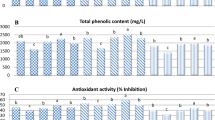Abstract
The aim of this study was to evaluate and compare the physicochemical, nutritional, and sensory properties of homemade fresh tomato juices prepared using 2 types of household juicers, a high-speed centrifugal juicer (HSC juicer) and a low-speed masticating juicer (LSM juicer). Juice yield, soluble solids, and the contents of total polyphenol, vitamin C, and lycopene in LSM tomato juice were significantly higher than those in HSC tomato juice. The DPPH radical scavenging activity of LSM tomato juice was also higher than that of HSC tomato juice. HSC tomato juice easily separated into 2 layers with many fine bubbles, while LSM tomato juice was homogeneous. Sensory evaluation revealed that panels significantly preferred LSM tomato juice to HSC tomato juice. In conclusion, the LSM juicer shows several advantages over the HSC juicer for preparing tomato juice of superior quality and taste that is rich in antioxidant phytochemicals at a high yield.
Similar content being viewed by others
References
Gil MI, Tomas-Barberan FA, Hess-Pierce B, Holcroft DM, Kader AA. Antioxidant activity of pomegranate juice and its relationship with phenolic composition and processing. J. Agr. Food Chem. 48: 4581–4589 (2000)
Chong MFF, Macdonald R, Lovegrove JA. Fruit polyphenols and CVD risk: A review of human intervention studies. Brit. J. Nutr. 104: S28–S39 (2010)
Dani C, Oliboni LS, Vanderlinde R, Bonatto D, Salvador M, Henriques JAP. Phenolic content and antioxidant activities of white and purple juices manufactured with organically- or conventionally-produced grapes. Food Chem. Toxicol. 45: 2574–2580 (2007)
Iyer MM, Sacks GL, Padilla-Zakour OI. Impact of harvesting and processing conditions on green leaf volatile development and phenolics in Concord grape juice. J. Food Sci. 75: C297–C304 (2010)
Uckoo RM, Jayaprakasha GK, Balasubramaniam VM, Patil BS. Grapefruit (Citrus paradisi Macfad) phytochemicals composition is modulated by household processing techniques. J. Food Sci. 77: C921–C926 (2012)
Willcox JK, Catignani GL, Lazarus S. Tomatoes and cardiovascular health. Crit. Rev. Food Sci. Nutr. 43: 1–18 (2003)
Arab L, Steck S. Lycopene and cardiovascular disease. Am. J. Clin. Nutr. 71: 1691s–1695s (2000)
Stella SP, Ferrarezi AC, dos Santos KO, Monteiro M. Antioxidant activity of commercial ready-to-drink orange juice and nectar. J. Food Sci. 76: C392–C397 (2011)
Navarro P, Nicolas TS, Gabaldon JA, Mercader-Ros MT, Calín-Sánchez Á, Carbonell-Barrachina ÁA, Pérez-López AJ. Effects of cyclodextrin type on vitamin C, antioxidant activity, and sensory attributes of a mandarin juice enriched with pomegranate and goji berries. J. Food Sci. 76: S319–S324 (2011)
Singleton VL, Orthofer R, Lamuela-Raventós RM. Analysis of total phenols and other oxidation substrates and antioxidants by means of folin-ciocalteu reagent. Method. Enzymol. 299: 152–178 (1999)
Furusawa N. Rapid high-performance liquid chromatographic identification/quantification of total vitamin C in fruit drinks. Food Control 12: 27–29 (2001)
Perkins-Veazie P, Collins JK, Pair SD, Roberts W. Lycopene content differs among red-fleshed watermelon cultivars. J. Sci. Food Agr. 81: 983–987 (2001)
Blois M. Antioxidant determination by use of free radical stable. Nature 181: 1199–1200 (1958)
Minoggio M, Bramati L, Simonetti P, Gardana C, Iemoli L, Santangelo E, Mauri PL, Spigno P, Soressi GP, Pietta PG. Polyphenol pattern and antioxidant activity of different tomato lines and cultivars. Ann. Nutr. Metab. 47: 64–69 (2003)
Wootton-Beard PC, Moran A, Ryan L. Stability of the total antioxidant capacity and total polyphenol content of 23 commercially available vegetable juices before and after in vitro digestion measured by FRAP, DPPH, ABTS, and Folin-Ciocalteu methods. Food Res. Int. 44: 217–224 (2011)
Gregory III JF. Ascorbic acid bioavailability in foods and supplements. Nutr. Rev. 51: 301–303 (1993)
Jacob K, Periago MJ, Böhm V, Berruezo GR. Influence of lycopene and vitamin C from tomato juice on biomarkers of oxidative stress and inflammation. Brit. J. Nutr. 99: 137–146 (2008)
Szeto YT, Tomlinson B, Benzie IFF. Total antioxidant and ascorbic acid content of fresh fruits and vegetables: Implications for dietary planning and food preservation. Brit. J. Nutr. 87: 55–59 (2002)
Kim JY, Paik JK, Kim OY, Park HW, Lee JH, Jang Y, Lee JH. Effects of lycopene supplementation on oxidative stress and markers of endothelial function in healthy men. Atherosclerosis 215: 189–195 (2011)
Marković K, Hruškar M, Vahčić N. Lycopene content of tomato products and their contribution to the lycopene intake of Croatians. Nutr. Res. 26: 556–560 (2006)
Sánchez-Moreno C, Plaza L, de Ancos B, Cano MP. Nutritional characterisation of commercial traditional pasteurised tomato juices: Carotenoids, vitamin C, and radical-scavenging capacity. Food Chem. 98: 749–756 (2006)
Böhm V, Bitsch R. Intestinal absorption of lycopene from different matrices and interactions to other carotenoids, the lipid status, and the antioxidant capacity of human plasma. Eur. J. Nutr. 38: 118–125 (1999)
Kim JY, Lee JY, Lee WY, Yi Y, Lim Y. Anti-oxidant property and inhibition of melanin synthesis of eight plant extracts. Korean J. Microbiol. Biotechnol. 38: 414–419 (2010)
Gonzalez ME, Jernstedt JA, Slaughter DC, Barrett DM. Influence of cell integrity on textural properties of raw, high pressure, and thermally processed onions. J. Food Sci. 75: E409–E416 (2010)
Cabrera SG, Moon K. A study of the physicochemical, functional, and sensory properties of farm produced and commercially produced grape juice in the Korean market. Food Sci. Biotechnol. 16: 740–746 (2007)
Kim HY, Kim MJ, Woo EY. Physicochemical and sensory properties of freshly squeezed orange juice using domestic and imported oranges. Korean J. Food Culture 15: 189–194 (2000)
Author information
Authors and Affiliations
Corresponding author
Rights and permissions
About this article
Cite this article
Kim, MJ., Kim, JI., Kang, MJ. et al. Quality evaluation of fresh tomato juices prepared using high-speed centrifugal and low-speed masticating household juicers. Food Sci Biotechnol 24, 61–66 (2015). https://doi.org/10.1007/s10068-015-0010-6
Received:
Revised:
Accepted:
Published:
Issue Date:
DOI: https://doi.org/10.1007/s10068-015-0010-6




